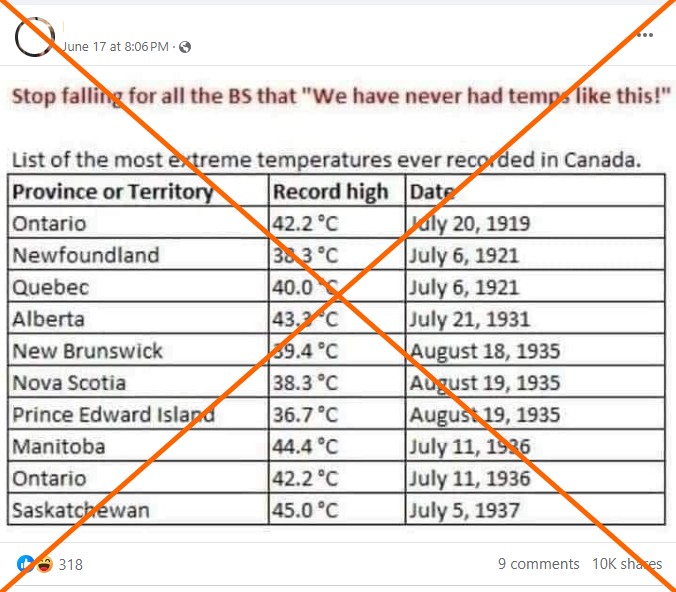One of the categories in the table is titled “Province or Territory,” but four Canadian jurisdictions are missing from the social media posts: NunavutYukon, the Northwest Territories and British Columbia.
Simon Donnerprofessor and climate scientist at the University of British Columbia (archived here), said these omissions are significant because they ignore all provincial and territorial temperature data measured in the 21st century, including the all time canadian extreme from 49.6C (121.2F) set in Lytton, British Columbia on June 29, 2021.
“It’s just a sampling of data that doesn’t represent the most extreme temperatures that have been recorded in Canada,” Donner said on July 3, 2024.
Heat Dome 2021
In June 2021, North America experienced a stagnant bubble of hot air that set temperature records in the western U.S. and Canada. Donner said the omission of British Columbia not only excluded the national record in Lytton, but also ignored the other cases of extreme heat in the province that summer.
“And that’s not counting the 2021 heat wave that killed hundreds of Canadians,” he said.
According to local reports from health authorities estimation About 600 people died in Canada as a result of extreme temperatures in June. The day after the national heat record was set in Lytton, the British Columbia town was almost completely destroyed due to a nearby forest fire.
While misleading social media posts warning of recent extremes are overreactions, researchers are to predict that heat domes like those experienced in 2021 will become more intense due to human-caused climate change (archived here).
There is a almost universal consensus that the burning of fossil fuels is causing average temperatures on Earth to rise (archived here). Donner said that historically, cooler regions have warmed faster than other parts of the world and that the lack of contrast between temperatures slows down the movement of weather patterns that allow heat domes to establish and intensify over longer periods of time (archived here).
Melody LONTJENSSabrina BLANCHARDAFP
“We’re seeing more of these kinds of blocking events and more slow air movement in the upper atmosphere,” Donner said. “And that follows from what you would expect from adding greenhouse gases to the atmosphere.”
During a heat dome in June 2024, seen over the east coast of North America, AFP debunked separate claims that predictions of extreme temperatures were exaggerated.
What is in the data?
Environment and Climate Change Canada (ECCC system) maintains climate measurements dating back to the 19th century in the country and shared the highest provincial and territorial temperature records with AFP on July 2.
According to ECCC data, two more records were set in the 21st century that the image on social media does not show: 36.5C (97.7F) in Yukon in 2004 and 39.9C (103.82F) in the Northwestern areasalso during the heat dome of June 2021 (archived here And hereThe ECCC reported that the highest temperature ever recorded Nunavut was 34.9 C (94.82 F) in 1989, ahead of the region divorced from the Northwest Territories (archived here And here).
Outside the province and territories not included in the social media graph, ECCC data showed higher and later records than those reported in the Alberta, Ontario And Quebec (archived here, here And here).
For Newfoundland and Labrador, ECCC delivered an equal record of 37.8 °C (100.4 °F), measured twice in 1944 And 1953 (archived here And here). While a temperature in that province on July 6, 1921 of 38.3 C (100.9 F) as seen in the social media posts, to exist in the historical data of the government agency (archived hereECCC spokesperson Hannah Boonstra said it was not included in the list of provincial and territorial data because the measurement needed to be validated.
“It is possible that the value is considered valid, but it has been removed from the provided table until its validity can be confirmed at a later date,” Boonstra said.
The ECCC say online that some historical measurements may be incorrect and Boonstra explained that daily maximum temperature values are compared with hourly temperatures and measurements from surrounding stations to assess whether a value is suspect (archived here).
Canada is warming faster
A 2019 study from the Canadian government reported that the country is warming twice as fast as the rest of the world (archived here). Travis Moorea researcher in climate and atmospheric science and extreme weather from Concordia University (archived here), also said the highest annual average temperatures were in Canada included during the last two decades (archived here).
Moore said that as temperatures rise, colder areas will feel the impacts faster. He was struck by the lack of information about northern Canadian areas in the social media posts.
“The north also has some very, very impressive records,” he said.
Canada’s Arctic regions are warming even faster than the rest of the country. 2022 Finnish study (archived here) found that melting sea ice provides less surface area to reflect solar radiation and that northern regions absorb more heat, creating a positive warming loop.
Moore emphasized thatWhile Canada and the North are warming faster, all of these rates are calculated based on global averages, with 2023 set to be the warmest year on record. file.
Read more about AFP’s reporting on climate change and environmental disinformation here.







